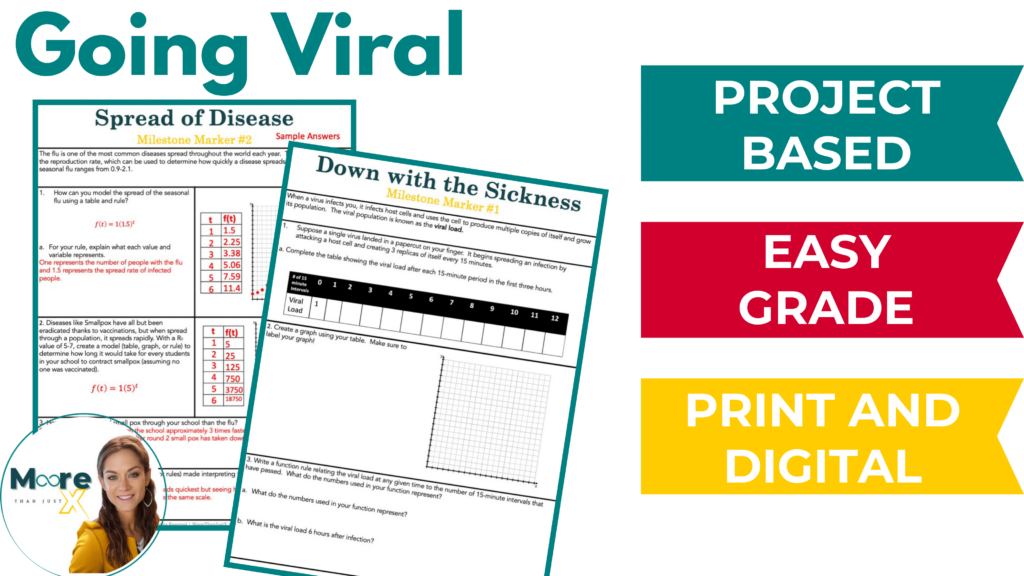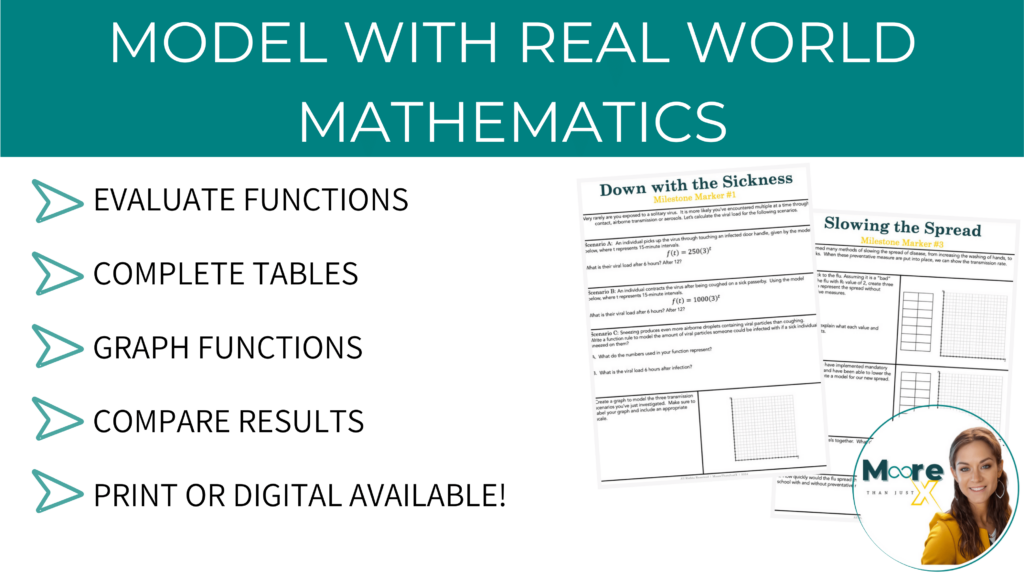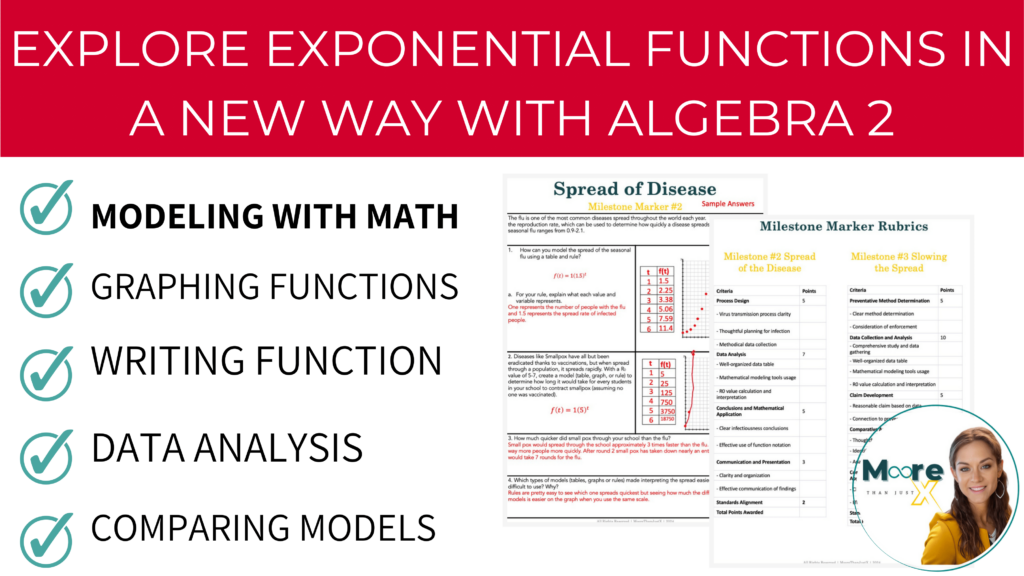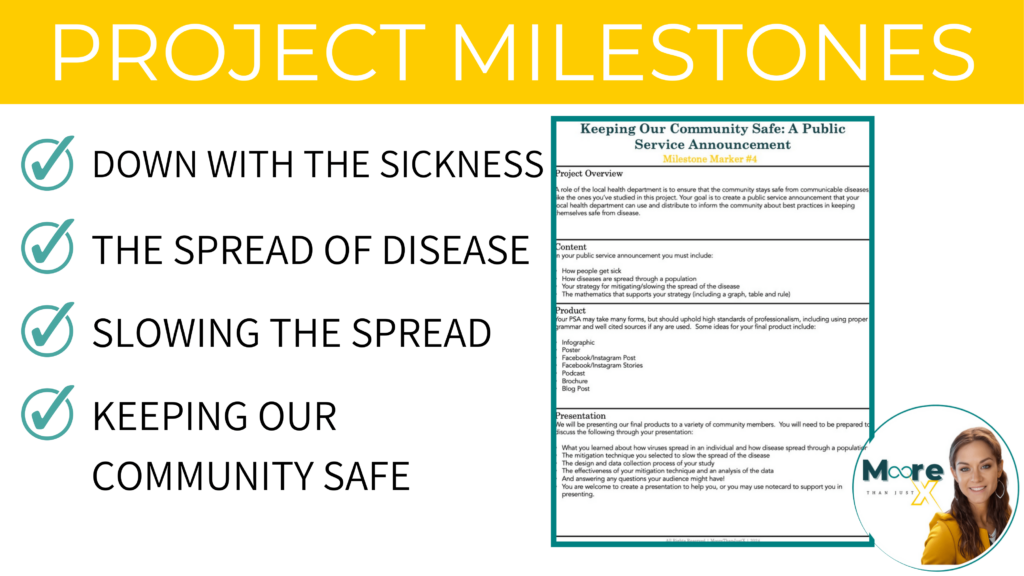Exponential functions have a way of making even the most math-loving students throw their hands up in frustration.
It’s not that the concept itself is impossible to grasp—it’s that the way it’s often taught feels disconnected from anything students care about.
They’re left wondering why they need to know what happens when x doubles or how graphs curve toward infinity.
Exponential functions aren’t just abstract math—they’re the key to understanding so many real-world phenomena, from how investments grow to the way diseases spread.
When students see how exponential functions play out in the world around them, the math stops feeling like busywork and starts to click.
In this post, we’ll explore fresh ways to teach exponential functions so your students don’t just get it—they’ll see why it matters.
But if you’re in a rush?
I have an incredible project based learning opportunity that helps them explore how and why viruses spread.
➡️ Click here to learn more, or to buy it from my TeachersPayTeachers store!
About Kristen and Moore Than X
I’m a high school math teacher who’s passionate about project-based learning, and making math relevant for students.
You can learn more about me and Moore Than X here.
View this post on Instagram
A post shared by Kristen | The Modern Math Teacher Podcast (@moorethanjustx)
Exponential functions can feel intimidating to students.
It’s not because they’re too complex, but because the concept of rapid growth isn’t something they encounter daily.
Add in abstract terms like “asymptotes” and “exponential decay,” and it’s no wonder their eyes glaze over.
The real challenge is helping students see what exponential functions actually represent.
These aren’t just numbers on a graph—they’re a way to explain real-world phenomena that they interact with every day. Think about it:
- Social Media Trends: The way a viral TikTok video racks up views.
- Financial Growth: How compound interest turns a small savings account into something much bigger over time.
- Science in Action: The spread of a cold through their school (which, let’s be honest, they probably contributed to).
Without tying the math to these tangible examples, exponential functions can feel like just another abstract math topic.
And when students don’t see the point, their motivation to learn plummets.
The good news? You can flip the script by anchoring your lessons in real-life applications.
When students connect exponential growth to things like money, social media, or even disease outbreaks, they start to understand the power behind these equations.
That’s when the lightbulb moments happen.
How to Make Exponential Functions Relatable and Engaging
If you want exponential functions to really stick with your students, you have to go beyond the textbook.
The trick? Tie the math to things they already care about.
When students see how exponential functions show up in their lives, the concept stops being abstract and starts making sense.
Here are a few ways to make that happen:
1. Start Small and Build Up
Kick things off with simple, relatable examples. One classic activity is the “penny doubling” problem: if you start with one penny and double it every day for a month, how much money would you have? Spoiler alert: it’s over $5 million! It’s a quick way to show exponential growth in action and get students curious about how it works.
2. Make It About Them
Nothing grabs a student’s attention like math that feels personal. Have them track something from their own lives, like the growth of their TikTok followers or how quickly a piece of school gossip spreads. These examples aren’t just fun—they’re also highly relevant and easy to model using exponential functions.
3. Use Visuals and Technology
Sometimes, students just need to see it to get it. Graph exponential functions using tools like Desmos or GeoGebra, or even plot them by hand to show how quickly the curve takes off. Pair graphs with real-life data, like COVID-19 case numbers or population growth, to reinforce the connection between math and reality.
4. Tie It to Current Events
Exponential functions are everywhere in the news—think about how scientists track climate change, how tech companies project user growth, or how epidemiologists predict the spread of diseases. Bring in these examples to show how the math they’re learning has a direct impact on understanding and solving real-world problems.
5. Turn It Into a Challenge
Want to keep things competitive? Present students with a “viral video” challenge where they calculate how quickly a hypothetical video gains views.
The goal? Students wil figure out when their video will hit a million views based on exponential growth.
By grounding exponential functions in things that feel real and relevant, you can turn a topic that usually leads to blank stares into one that sparks curiosity and conversation. And isn’t that the ultimate teaching win?!
➡️ Try this project based learning activity that’s all about using exponential functions in real life!
Project-Based Learning: The Key to Teaching Exponential Functions
Sometimes, the best way to teach a tricky concept is to let students discover it for themselves. That’s where project-based learning (PBL) comes in. With PBL, students take ownership of their learning by diving into real-world scenarios that bring exponential functions to life. It’s hands-on, engaging, and—most importantly—memorable.
1. Model the Spread of a Disease
Have students simulate how a disease spreads through a population. Start small: maybe one person is “infected” on day one, and they infect two people each day after that. Ask students to create a table and graph showing how quickly the number of cases grows. From there, introduce real-world elements, like vaccination rates or social distancing, and see how those variables affect the model. It’s a fascinating way to connect math to science while reinforcing the power of exponential growth.
2. Analyze Social Media Virality
Want to make exponential functions feel super relevant? Tie them to social media trends. Ask students to track how a video or post goes viral, starting with one viewer and doubling every hour. Challenge them to calculate how long it would take to reach 1,000, 10,000, or even a million views. Bonus points if they come up with creative ways to model the data, like using a graphing tool or a time-lapse presentation.
3. Build a Financial Growth Plan
Exponential functions are at the heart of financial literacy, and this is a great chance to teach both at once. Have students create a savings plan where they calculate how their money grows with compound interest. They can start with different initial amounts and interest rates, then compare how each scenario plays out over time. It’s a practical, real-world application that teaches math and life skills all in one.
4. Create a Public Service Announcement
Wrap up a project-based unit with a creative twist: have students turn their findings into a PSA. Whether they’re explaining how to slow the spread of a disease or encouraging their peers to start saving early, they’ll use data and exponential models to support their case. It’s a great way to reinforce their understanding while practicing communication skills—and the finished projects are always a hit.
Project-based learning takes exponential functions from something students passively learn to something they actively explore.
Tips for Making Exponential Functions Stick
Once you’ve got your students hooked with real-world examples and hands-on projects, it’s time to reinforce those lessons so the concepts really stick.
Here are a few tips to try!
Encourage Students to Ask “What If?”
Push students to tweak variables in their models and ask questions like, “What happens if the growth rate doubles?” or “What if the population starts at 10 instead of 1?” Exploring these “what if” scenarios not only deepens their understanding but also keeps them engaged.
Celebrate Mistakes as Learning Moments
When students inevitably make mistakes (like misinterpreting a graph or setting up an equation), treat those moments as opportunities. Show them how to identify and fix errors—it’s a valuable skill they’ll carry far beyond math class.
Break It Into Manageable Steps
Exponential functions can feel overwhelming when tackled all at once. Scaffold your lessons by starting with simple growth models and gradually adding complexity. For example, begin with doubling numbers, then introduce graphs, and finally layer in real-world data and calculations.
Incorporate Group Work
Let students collaborate on projects or problem-solving activities. Working in groups encourages discussion and helps them learn from each other’s perspectives. Plus, explaining their thinking out loud reinforces their own understanding.
Tie It Back to Their Interests
Whenever possible, use examples that resonate with your students. Whether it’s TikTok trends, video game stats, or their dream of saving up for a new phone, connecting exponential functions to what they care about makes the math feel relevant and personal.
Exponential functions don’t have to be a source of frustration—for you or your students.
By grounding your lessons in real-world applications, embracing project-based learning, and reinforcing concepts with creative strategies, you can make exponential growth one of the most exciting parts of your curriculum.
Whether your students are modeling the spread of a virus, tracking viral social media trends, or planning for financial success, exponential functions become more than just numbers on a graph—they become tools for understanding and navigating the world around them.
And if you want to try that project with your students, try this project I made!
- Digital and printable versions are included
- It’s super easy to grade
- Best of all– your students can succeed with it, even if it’s your first time trying project-based learning













